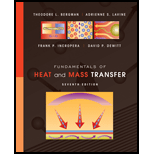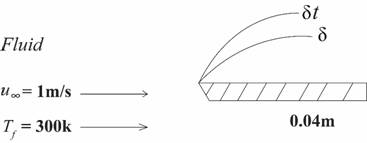
Consider the following fluids at a film temperature of 300 K in parallel flow over a flat plate with velocity of 1 m/s: atmospheric air, water, engine oil, and mercury.
- For each fluid, determine the velocity and thermal boundary layer thicknesses at a distance of 40 mm from the leading edge.
- For each of the prescribed fluids and on the same coordinates, plot the boundary layer thicknesses as a function of distance from the leading edge to a plate length of 40 mm.
(a)
The velocity and thermal boundary layer thickness at a distance of
Answer to Problem 7.1P
The thermal boundary layer thickness for air, water, oil and mercury is 4.48, 0.52, 1.27, and 1.17 respectively.
Explanation of Solution
Given Information:
Properties of air at
Properties of water at
Properties of engine oil at
Properties of mercury at
Concept used:
The equation of Reynolds number is
The formula for nusselt number is
The formula for average nusselt number is
The formula of laminar
Nusselt number:
It is the ratio of convective heat transfer to convective heat transfer across a boundary.
Where
Calculation:
Know that the equation of Reynolds number.
From the figure:

Put
Put
Know that the formula of laminar
Put
Convert the unit of laminar
Know that the formula of laminar
Put
Put
Know that the formula of laminar
Put
Know that the formula of laminar
Put
Put
Know that the formula of laminar
Put
Know that the formula of laminar
Put
Put
Know that the formula of laminar
Put
Know that the formula of laminar
Put
Conclusion:
Hence, the thermal boundary layer thickness for air, water, oil and mercury is 4.48, 0.52, 1.27, and 1.17 respectively.
b)
To draw: the boundary layer thickness from the leading edge to a plate length of
Answer to Problem 7.1P
Created the graph for determined values of thermal boundary layer thickness for air, water, oil and mercury is 4.48, 0.52, 1.27, and 1.17 respectively with the values oflaminar thermal boundary layer
Explanation of Solution
Given Information:
The thermal boundary layer thickness for air, water, oil and mercury is 4.48, 0.52, 1.27, and 1.17 respectively.
Entire length
Boundary layer
Concept used:
Plot the graph by Matlab software, obtained values by formulas correlation between Reynolds equation, Nusselt number, average nusselt number and boundary layer thickness.
Calculation:
Know that the determined values of thermal boundary layer thickness for air, water, oil, mercury are 4.48, 0.52, 1.27, and 1.17 respectively and determined values of the laminar thermal boundary layer are
Substitute the values of thermal boundary layer thickness and laminar thermal boundary on the graph.

Conclusion:
Created the graph for determined values of thermal boundary layer thickness for air, water, oil and mercury is 4.48, 0.52, 1.27, and 1.17 respectively with the values oflaminar thermal boundary layer
Want to see more full solutions like this?
Chapter 7 Solutions
Fundamentals of Heat and Mass Transfer
- Given answers to be: i) 14.65 kN; 6.16 kN; 8.46 kN ii) 8.63 kN; 9.88 kN iii) Bearing 6315 for B1 & B2, or Bearing 6215 for B1arrow_forward(b) A steel 'hot rolled structural hollow section' column of length 5.75 m, has the cross-section shown in Figure Q.5(b) and supports a load of 750 kN. During service, it is subjected to axial compression loading where one end of the column is effectively restrained in position and direction (fixed) and the other is effectively held in position but not in direction (pinned). i) Given that the steel has a design strength of 275 MN/m², determine the load factor for the structural member based upon the BS5950 design approach using Datasheet Q.5(b). [11] ii) Determine the axial load that can be supported by the column using the Rankine-Gordon formula, given that the yield strength of the material is 280 MN/m² and the constant *a* is 1/30000. [6] 300 600 2-300 mm wide x 5 mm thick plates. Figure Q.5(b) L=5.75m Pinned Fixedarrow_forwardHelp ارجو مساعدتي في حل هذا السؤالarrow_forward
- Q10) Body A weighs 600 lb contact with smooth surfaces at D and E. Determine the tension in the cord and the forces acting on C on member BD, also calculate the reaction at B and F. Cable 6' 3' wwwarrow_forwardHelp ارجو مساعدتي في حل هذا السؤالarrow_forwardQ3: Find the resultant of the force system.arrow_forward
- Question 1 A three-blade propeller of a diameter of 2 m has an activity factor AF of 200 and its ratio of static thrust coefficient to static torque coefficient is 10. The propeller's integrated lift coefficient is 0.3.arrow_forward(L=6847 mm, q = 5331 N/mm, M = 1408549 N.mm, and El = 8.6 x 1014 N. mm²) X A ΕΙ B L Y Marrow_forwardCalculate the maximum shear stress Tmax at the selected element within the wall (Fig. Q3) if T = 26.7 KN.m, P = 23.6 MPa, t = 2.2 mm, R = 2 m. The following choices are provided in units of MPa and rounded to three decimal places. Select one: ○ 1.2681.818 O 2. 25745.455 O 3. 17163.636 O 4. 10727.273 ○ 5.5363.636arrow_forward
 Principles of Heat Transfer (Activate Learning wi...Mechanical EngineeringISBN:9781305387102Author:Kreith, Frank; Manglik, Raj M.Publisher:Cengage Learning
Principles of Heat Transfer (Activate Learning wi...Mechanical EngineeringISBN:9781305387102Author:Kreith, Frank; Manglik, Raj M.Publisher:Cengage Learning
